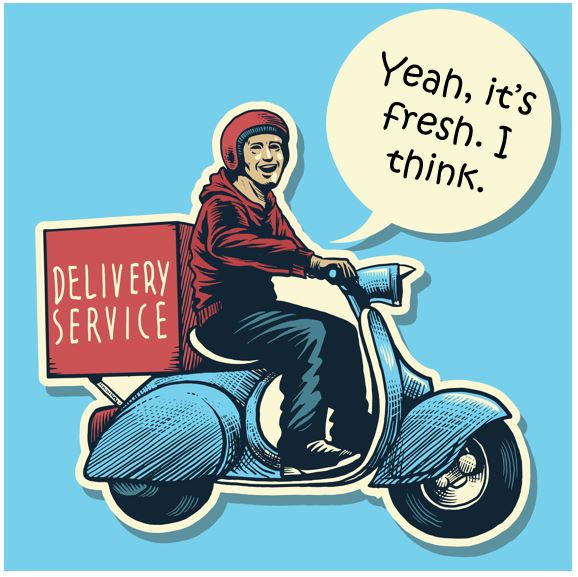Have you had problems with food service delivery? The restaurant business is changing and is vastly different than it was only a few years ago.
Like perhaps many of you, I worked my way through college as a waiter. On the best days, working in a restaurant is chaotic but restaurants today are nothing like when I was in college. Nowadays, there’s a lot more going on.
Today’s Food Service Delivery Challenges
Today’s restaurants have to deal with a variety of new challenges when it comes to food service delivery – challenges that are stressing and straining their operations:
- The increase in delivery or takeout orders negatively impacting dine-in traffic.
- Having to deal with delivery by their own staff as well as dealing with services like Door Dash and Uber Eats.
- Quality control issues associated with takeout and delivery orders.
In an article about Red Robin in National Restaurant News (full disclosure, they are not a current customer), their CEO Denny Marie Post stated “The first and primary issue facing us today is … the decline of dine-in traffic.” Customers are increasingly looking for restaurant menu items delivered fast and fresh to their homes – and that’s more complicated than many would think.
Writing in Food Safety and Quality magazine, Chris Boyles outlines four areas restaurants need to focus on when dealing with food service delivery:
- Maintain food quality and safety in transit.
- Measure results and continually re-evaluate.
- Optimize your kitchen and restaurant for delivery.
- Develop a clear policy for customer action.
It’s a great article and I want to drill down on the first two points above, though all four are important.
Maintaining Food Quality and Safety in Transit
When you are producing food for delivery, you have to consider how the food is prepared and packaged compared to when it is served in the restaurant. That may seem obvious but if you’re delivering a hamburger, you have to consider if the bun will get soggy in the 10-20 minutes (or more) it will take to get from the kitchen to the customer. You also have to factor in whether the item is meant to be refrigerated or kept hot. This is not only a food safety issue but also a quality and branding issue. If the customer orders a cobb salad and it’s packed next to a hot roasted chicken, the quality and presentation of both are likely to suffer. That’s not an issue when served dine-in at the restaurant but it can be a huge issue when it comes to delivery as the customer will generally blame the restaurant, and not the delivery person, when the salad is warm and the chicken is cold. The result: your brand and potential for repeat business suffers.
Restaurants also need to determine if they want to offer all menu items or just a select few. Do you want to “mass produce” some items in the off-peak times for delivery during peak times so as to improve your asset utilization? If so, you have even more complexity as the length of time that food is held can determine if you’re considered a restaurant or a caterer – and different regulations can apply.
Measure Results and Continually Re-evaluate
To ensure quality and compliance, it’s really critical to have data. But restaurants generally aren’t set up to collect data about food destined for delivery. How long is the food waiting before it’s picked up? How long from pick up to delivery? Was it kept at the right temperature from preparation to when the customer receives it? What’s the customer’s satisfaction? Were there issues? Without data from this “mini supply chain,” you can’t measure and evaluate results.
Zest Delivery Helps Restaurants Solve These Challenges
Zest Delivery is a solution specifically designed to help restaurants better manage the food service delivery process, from preparation through receipt by the consumer.
- Dispatcher Monitoring provides real-time dispatcher visibility for each delivery bag from the restaurant through delivery. Real-time alerts provide notifications of out-of-compliance handling or bag operations. Bags are monitored for power, temperature, humidity and bag open/close.
- Pre-staging Meals for on-demand delivery helps save time – a primary factor in the ordering process. Restaurants can cater to this preference by offering a fixed menu of popular items that can be pre-staged with delivery vehicles. This can provide a significant time advantage. Pre-staging meals has the benefits of faster delivery as well as enabling meal prep to occur ahead of peak restaurant traffic time.
- Ensure Customer Satisfaction by actively managing meal temperatures for deliveries to provide dine-in quality as well as extending pre-staging times for on-demand menu items. Zest Delivery provides customer meal heating/cooling profiles to maintain ideal temperature and humidity for both hot and cold foods. This means dispatchers can validate delivered quality and cancel meals that no longer meet quality standards – avoiding dissatisfied customers and potential food safety issues – a real threat to a restaurant’s reputation.
- Confirm Food Safety by actively managing meal temperature – the first requirement in preventing issues. Zest Delivery provides the ability to directly disqualify food for delivery based on real-time data about the food’s condition and handling.
As restaurants expand their business models to address changing customer preferences, Zest Delivery can help ensure that quality and safety are managed by providing restaurateurs with the data, insights and alerts they need to properly manage processes and quality. You can learn more about Zest Delivery.


